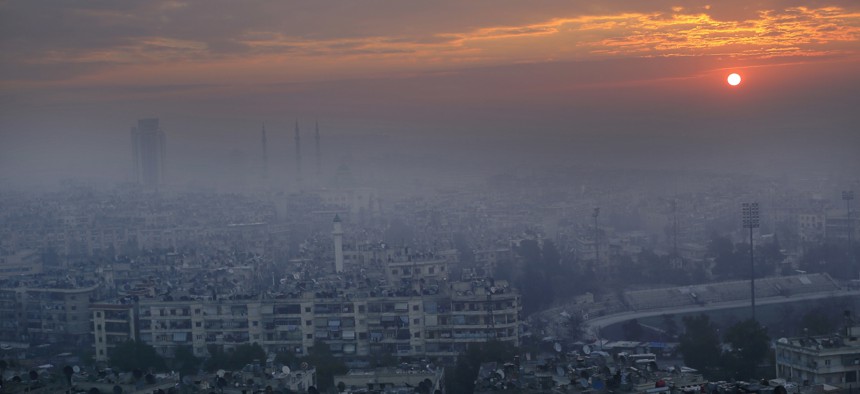
In this Jan. 20, 2017 file photo, the sun rises as blanket of fog covers the Aleppo citadel and the city of Aleppo, Syria. Hassan Ammar/AP
UN Report Alleges Syrian War Crimes in Aleppo, Rebutting Russian Denials
The document backs up open-source and think-tank reporting on the Assad regime’s use of chlorine gas.
The Assad government likely committed numerous war crimes in its 2016 assault on Eastern Aleppo, including dropping chlorine bombs from helicopters, according to a new U.N. report that rebuts repeated Kremlin claims and validates months of reporting by open source-media outlets and U.S. think tanks. The report appeared online on Wednesday, hours after Russia and China vetoed a U.N. proposal to sanction Syria for the gas attacks.
The March 1 document describes numerous reports of chlorine attacks by Syrian forces in Aleppo. It follows consistent reporting on the Syrian government’s use of chlorine by the open-source intelligence group Bellingcat. Human Rights Watch has also documented the Assad regime’s deployment of chlorine in civilian areas of Aleppo.
The use of chlorine as a weapon goes back to World War I (as well-documented by science writer Sarah Everts). German scientist Fritz Haber was a strong advocate for the weaponization of the substance, which was inexpensive and widely used to dye textiles. It was heavier than air and so it could seep into the soil. In the lungs, chlorine combines with moisture to produce hydrochloric acid. Victims drown in their own blood as their bodies dissolve from within. In sufficient doses, it can strangle a victim in seconds.
Its first combat use came on April 22, 1915. Around 5:30 p.m., German soldiers near the Belgian town of Ypres opened canisters of chlorine, which drifted downwind to a group of French soldiers. Canadian infantryman A.T. Hunter described the scene: “Passive curiosity turned to active torment—a burning sensation in the head, red-hot needles in the lungs, the throat seized as by a strangler...Many fell and died on the spot. The others, gasping, stumbling, with faces contorted, hands wildly gesticulating, and uttering hoarse cries of pain, fled madly through the villages and farms and through Ypres itself, carrying panic to the remnants of the civilian population.”
A century later, the U.N. report notes at least three instances when Syrian regime forces dropped chlorine from helicopters in Aleppo between July and December 2016. Here’s the report on a Sept. 6 gas attack in the neighborhood of Sukkari that took the life of at least one child: “A man and a 13-year-old girl died as a result of asphyxiation, while more than 80 civilians suffered from the effects of chlorine inhalation. Eyewitnesses saw helicopters hovering in the sky when the bomb was dropped, while those in the vicinity began suffocating and their eyes became red shortly afterwards. Witnesses further reported a strong odour resembling domestic detergents.”
Russia’s deputy ambassador to the U.N., Vladimir Safronkov has said that there is “no convincing evidence” that the chemical weapons were used by Syrian forces.
But the U.N. report backs up Bellingcat’s documentation of the Sept. 6 incident and others. Nor is it the only corroborating work; the Atlantic Council’s Feb. 13 “Breaking Aleppo” report also documents the Assad regime’s repeated use of chlorine gas, as well as its use of highly destructive incendiary weapons in civilian locations. The Atlantic Council report notes that aid workers and observers have reported at least six verifiable chlorine attacks by the government between October and December “with the remains of yellow chlorine gas cylinders, as documented at other sites over the preceding two and half years across Syria, recorded by local activists at many of the sites.”
The U.N. report notes that dropping chlorine on people constitutes a violation of international law in part because chlorine, like other chemical weapons, can’t discriminate between combatants and noncombatants. “The use of chlorine, regardless of the presence of a valid military objective, is prohibited by customary international humanitarian law as well as by the Convention on the Prohibition of the Development, Production, Stockpiling and Use of Chemical Weapons and on Their Destruction, to which the Syrian Arab Republic is a party,” it notes. “The continued use of chlorine by Syrian forces evinces a blatant disregard for international legal obligations, and also amounts to the war crime of indiscriminate attacks against a civilian population.”
The resolution that Russia blocked in the U.N. would have banned the sale of helicopters to the Syrian government.
